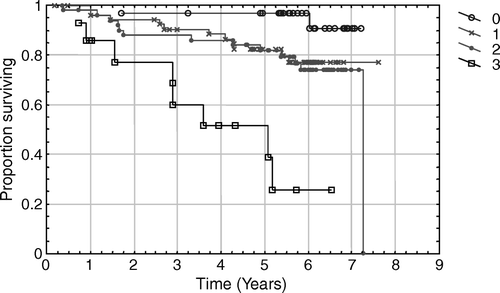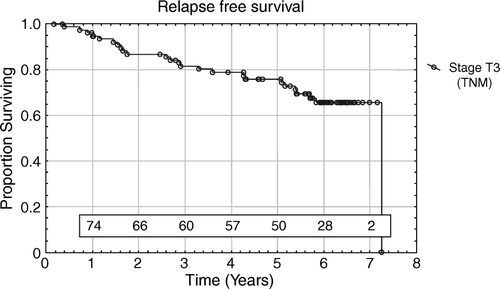Figures & data
Table I. Patient characteristics covering age at diagnosis, PSA levels, differentiation grade according to WHO, T-stage and N-stage.
Table II. Prognostic value of WHO grade, T-stage and PSA in PSA relapse-free survival. Tested by Cox regression multivariate analyses.
Table III. The calculated values for the probability of 5-year PSA relapse-free survival using nomograms for surgery and dose-escalated radiotherapy are demonstrated. The patient characteristics in this study are used. The result is divided into the number of risk factors in terms of PSA, T-stage and WHO grade. The actual result from the present study is also demonstrated.
Figure 1. PSA relapse-free survival related to the number of risk factors. The risk factors are defined as PSA >10 µg/l, T-stage = 3 and high grade prostate cancer WHO = 3.

Figure 2. PSA-relapse free survival in stage T3 patients. The number of patients at risk each year is noted in the diagram.

Figure 3. Side effects from urinary tract according to RTOG score and reported as proportion of patients at 6 weeks, 6 months and 6 years follow-up.

Figure 4. Side effects from lower intestinal tract according to RTOG score and reported as proportion of patients at 6 weeks, 6 months and 6 years follow-up.

Table IV. Radiobiological calculation for tumour tissue and the rectum: F = fractions, BED = biologically effective dose, Gy3 = assuming α/β = 3, NTD = normalized dose to 2Gy per fraction.
Table V. Review of the literature. Abbreviations: 3D EBRT = Three dimensional conformal external beam radiotherapy, HDR = high dose rate brachytherapy, NTD (α/β = 3) = Normalised dose to 2 Gy per fraction and alfa/beta ratio equal to 3, RFS = relapse free survival, RTOG GU = symptoms from the urogenital tract according to the Radiation Therapy Oncology Group, RTOG GI = symptoms from lower intestinal according to RTOG.